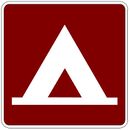903.13 State and Federal Recreation and Historic Site Signing
History. The State and Federal Recreational and Historic Site signing program was originally managed by MoDOT. MoDOT was the point of contact for state and federal agencies, MoDOT executed the contract, installed and maintain the signs that were installed.
In July 2015 a new Supplemental Guide Sign Program was established which consolidated the majority of MoDOT’s supplemental guide signs into one program and the management of this new program was contracted out to a 3rd party contractor. The MoDOT policy that once governed this signing program was incorporated into a new Code of State Regulations (CSR) which covers all the signing programs within the Supplemental Guide Sign Program.
Existing contracts between MoDOT and the state and federal agencies remain in place until their expiration date with MoDOT’s Supplemental Guide Sign contractor performing any required sign maintenance. Once these MoDOT contracts expire, the state and federal agencies will enter into new contracts with the Supplemental Guide Sign contractor for the duration of time their signs remain in place.
Support. State and Federal Recreation and Historic Site Signing placed on the MoDOT system are a form of traffic generator sign, as such they are included in the department Supplemental Guide Sign Program. These signs only provide guidance to these recreational and historic sites, signing within these facilities is the responsibility of the state or federal agency to install and maintain to MUTCD standards.
Standard. For this signing program, a State or Federal Recreation and Historic Sites is defined as a site owned and operated by a Missouri state agency (Missouri Department of Conservation or Missouri Department of Natural Recourse) or a federal agency (National Park Service, National Forest Service, Corps of Engineers, US Fish and Wildlife).
All requests for participation in the State and Federal Recreation and Historic Site Signing program shall be forwarded to MoDOT’s Supplemental Guide Sign Program manager for processing. Per the CSR, it is the program manager’s responsibility to receive all requests, evaluate eligibility and administer the contract with the applicant.
MoDOT districts’ role in the program is limited to reviewing and approving site plan reviews for new sign installations to assure these new sign installations are appropriate, looking for items such as, but not limited to, assuring the new installations do not conflict with existing traffic control devices, creating sight distance issues or create an issue for maintaining the right of way. Another critical responsibility is to identify and report damage and/or deficiencies with any of the sign the program manager is responsible for.
Central Office Highway Safety and Traffic Division shall be responsible for managing the Supplemental Guide Sign Program Contract, updating the CSR, interpreting the intent of the CSR and the program contract if there are questions or appeals from prospective applicants. Highway Safety and Traffic Division shall also be responsible for working with Governmental Relations on issues which may need to be addressed on the legislative side. If the Highway Safety and Traffic Division is unable to resolve an issue or concern it will be addressed by the Chief Safety and Operations Officer, Deputy Director and Chief Engineer and, if necessary, the Director.
The State and Federal Recreation and Historic Site Signing program shall be managed in accordance with the Code of State Regulations 7 CSR 10-17 Supplemental Guide Sign Program and the Supplemental Guide Sign Program contract between the Commission and MoDOT’s 3rd party contractor. The CSR is binding and has the effect of law. Exceptions and/or variations from the CSR are not permitted under normal conditions with the Director only having the authority to authorize such actions.
The rules contained within the CSR are based on, and are in conformance with, the Manual on Uniform Traffic Control Devices and the AASHTO Guidelines for the Selection of Supplemental Guide Signs for Traffic Generators.
Guidance. MoDOT utilizes very few of the recreational and cultural interest symbol signs included in MUTCD Chapter 2M as the majority of these symbol signs are only relevant inside the boundaries of a state or federal site. The symbol signs used on MoDOT right of way are typically limited to those that indicate the availability of camping at a site. These signs are installed as part of state and federal signing in the Supplemental Guide Sign Program managed by MoDOT’s 3rd party contractor and their use is based on a site by site evaluation. The design and size of the symbol signs should match MUTCD standards.
 |

|
Used on MoDOT Right of Way | |
Option. Rustic Signs may be used by state and federal agencies at first order locations, the intersection that leads drivers off the state system or at the entrance of the site when the state route passes through the recreational areas or historic site. Rustic signs do not meet Federal breakaway standards therefor when they are used they shall be placed at or outside of MoDOT’s right of way line for safety. These signs will typically replace MoDOT’s standard first order signing.
